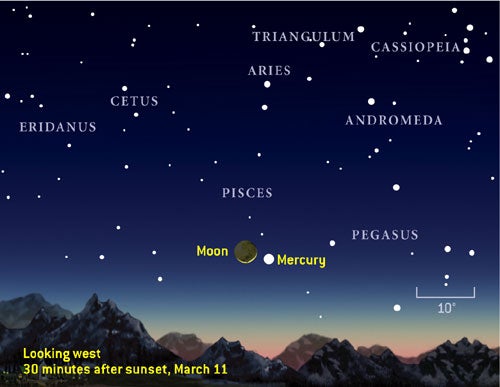Mercury — the closest planet to the Sun — makes its best evening appearance of the year this month. Half an hour to an hour after sunset, look low in the west for a bright dot piercing the deep orange to blue twilight sky. The planet was brightest March 1 when it stood 6° above the western horizon 30 minutes after sunset. (For comparison, your closed fist held at arm’s length spans 10°.) Each day after March 1, Mercury fades a bit, but even 2 weeks later it will be brighter than any star in its area.
Mercury will be easiest to find March 11, when a 2-day-old crescent Moon lies nearby. You can spy Mercury 4° to the Moon’s lower right, about 11° (a bit more than a fist’s width) up from the horizon in the west. A view of Mercury through a telescope that evening will reveal the planet’s small disk, which will appear 48-percent lit, similar to a quarter Moon.
The next evening, Mercury reaches a point called greatest elongation — its maximum distance from the Sun as seen from Earth. In the days following, Mercury remains fairly high but fades rapidly. On March 17 it lies 10° above the western horizon 30 minutes after sunset and sets 1 hour later. Mercury appears in front of the faint stars of Pisces the Fishes during this entire period of visibility.
Quick facts:










